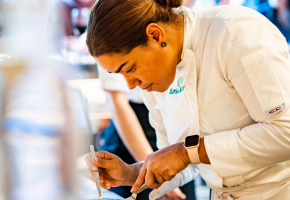It’s about time I made a public apology. For years, those lovely customers, followers and friends of mine, who’ve innocently asked me ‘What’s a Plantain?’ have got a brash, disdainful reply: It’s a starchy banana, darling.
Only recently, did I realise that this outward disinterest disguised my own ignorance. Being born and brought up in the coffee region of Colombia, plantains were as common to me as apples are to the English. But actually, but I never knew much about this fascinating and delicious vegetable, that has played a huge part in my life.
The Green Plantains originated in the Far East, in particular New Guinea and travelled to Africa (where they were first grown several thousand years ago) becoming a staple part of the diet on both continents where a tropical or a sub-tropical climate allowed them to flourish and form plants three to ten metres high.
During the 15th and 16th centuries, the mighty plantain migrated to the new colonies in South America, given to the slaves as an inexpensive and nutritious food. In the 1620s, more than 40,000 plantains were imported annually to Cartagena, where the resident slave population consumed them along with a diet of beans, cassava, yams, and corn, all staples of today’s Latin kitchens.
Known for its fertile land and coastal plains, Cuba became the transit point for Spanish expeditions in the New World, and provided ideal tropical climate conditions for plantain cultivation. Introduced into the United States in 1804, regular trade developed around harvests, and by the late 19th century, a significant industry emerged.
In the 20th century, with the migration of Latinos to the US, settling along the South Eastern coast (ideal climate for plantains) bananas and plantains became less expensive, and an integrated part of U.S. food history. But enough history for now; let’s get cooking!
Five ways to eat Plantain:
1. Patacones or Tostones. For this we use green plantains, fried in vegetable oil, then flattened with the help of a wet cloth and a rolling pin, until they are thin like a wafer. You then fry them again, until crispy like a potato crisp or tortilla chip. Add salt and pepper and use them with dips like guacamole…great for parties! With shredded beef on top they make great canapés. Or use them as a garnish with fish; my favourite one is with escabeche.

2. Aborrajados.
These are very ripe, almost black, plantains. When this ripe, they get very sweet and ideal for baking. Make a cut in the middle, length wise, put some butter in the slit and add white cheese like Mozzarella or Feta. Then bake for 30 minutes and you’ll get a delicious snack, or a dessert that goes very well with ice cream. Also fantastic on the barbeque!

3. Maduros
These pan-fried slices of ripe plantains go with almost any dish. Colombians, Venezuelans, and other Caribbeans will add these to almost any dish that is served with rice. A Bandeja Paisa isn’t the same without them!

4. Frijoles
Beans and plantains are the perfect marriage in the high Andes. Dice green plantains into small cubes and then added to the other ingredients to complement the pulses. This produces a hearty main course dish.
5. Sancocho, Sudados or Cocidos. All stews benefit greatly from adding a ripe plantain. They add sweetness and softness, and will complement the flavours of the meat and the other vegetables, such as cassava and potatoes.

Esnayder Cuartas is London’s pioneer of Latin–fusion cuisine and one of the city’s finest caterers, whose next pop-Up fine dining experience will be 'The Flavour f Latin America' a 1940's Havana style banquet at La Clave Fest. Info and tickets here www.laclavefest.co.uk/sabor. See preview below.



















